Tourism
Compared to most places in Greenland, only a few tourists end up in the Qaanaaq
area. This is because of the sometimes unstable transportation, making
it risky to arrange and offer tours as a finished "package".
After the new airfield near Qaanaaq becomes operational in the year 2000 this risk and inconvenience will be eliminated.
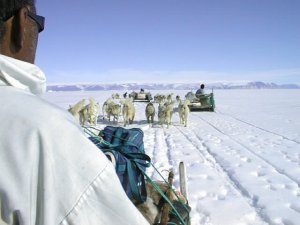 Most tourists coming to the district are therefore "do-it-yourself" tourists, with no particular expectation or need for a well functioning professional tourist service. Once you reach the district, you have many unique experiences awaiting. You can go traveling by dog sledge in the spring day and night sunshine together with Inuit hunters. Or you can go by sledge or boat from settlement to settlement and visit the hunters' camps. At all times you will be safely guided by cheerful Inuit hunters, who don't leave anything to chance.
Tourists who want to hunt can buy a tourist license to hunt most game
except polar bear, walrus and whales.
Most tourists coming to the district are therefore "do-it-yourself" tourists, with no particular expectation or need for a well functioning professional tourist service. Once you reach the district, you have many unique experiences awaiting. You can go traveling by dog sledge in the spring day and night sunshine together with Inuit hunters. Or you can go by sledge or boat from settlement to settlement and visit the hunters' camps. At all times you will be safely guided by cheerful Inuit hunters, who don't leave anything to chance.
Tourists who want to hunt can buy a tourist license to hunt most game
except polar bear, walrus and whales.
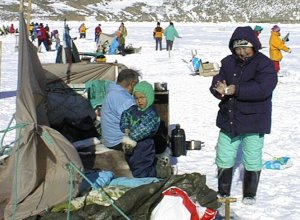 In early July cracks occur in the sea ice and many people go there to fish a kind of fish like small cod. It's mostly for fun and a "social" event with plenty of hot drinks and food. Time and length of these "parties" on the ice has no meaning at that time of year since the bright sun shines continuously as it makes a 360 degree circle overhead every 24 hours.
In early July cracks occur in the sea ice and many people go there to fish a kind of fish like small cod. It's mostly for fun and a "social" event with plenty of hot drinks and food. Time and length of these "parties" on the ice has no meaning at that time of year since the bright sun shines continuously as it makes a 360 degree circle overhead every 24 hours.
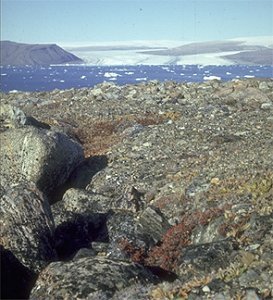 For the tourist who prefers walking in the mountains or on the icecap, there
are many possibilities. Only about one hour walking from Qaanaaq,
you can enter the smooth and not dangerous icecap. From here long
trips by foot or on ski can be enjoyed. The view from the top of the
cap is breathtaking. In clear weather there is free sight in almost
any direction.
For the tourist who prefers walking in the mountains or on the icecap, there
are many possibilities. Only about one hour walking from Qaanaaq,
you can enter the smooth and not dangerous icecap. From here long
trips by foot or on ski can be enjoyed. The view from the top of the
cap is breathtaking. In clear weather there is free sight in almost
any direction.
Shown here is hiking scenery near Dundas. The glacier across the fiord is approximately 6 miles away. Distances are deceiving because the air is so clear and dry.
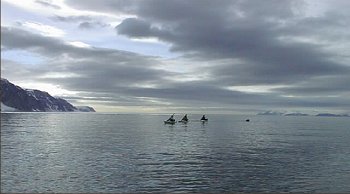 Some tourists prefer paddling a kayak in the area. With the
icefloes and the many icebergs, the sea is very often like a mirror and perfect
for kayaking. This is an excellent and quiet way to get close to sea mammals
like seals and narwhales and birds.
Some tourists prefer paddling a kayak in the area. With the
icefloes and the many icebergs, the sea is very often like a mirror and perfect
for kayaking. This is an excellent and quiet way to get close to sea mammals
like seals and narwhales and birds.
Shown here are hunters towing home a narwhale.
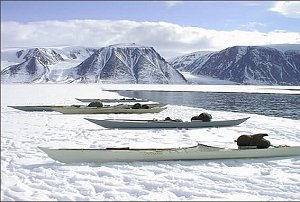 For kayak parties, trips can be arranged with guidance by Inuit hunters in their own "qajaq" or support by small boats.
For kayak parties, trips can be arranged with guidance by Inuit hunters in their own "qajaq" or support by small boats.
In the recent past years Qaanaaq has been popular as a overnight stop for tourists going to the North Pole. The Twin-Otters come in from Canada and
land on the local airstrip or on sea ice outside Qaanaaq.
|
Bring your camera and plenty of film
|
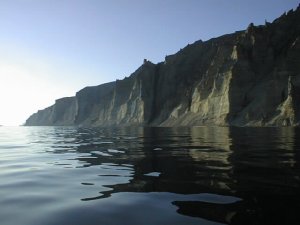
|
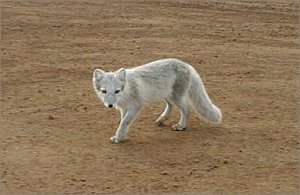
|
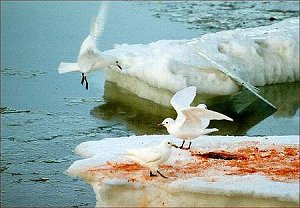
|
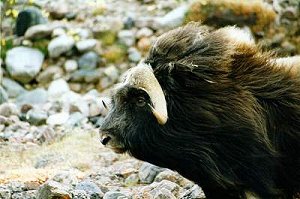
|
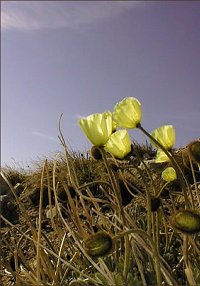
|

Back
to Directory
Counter for statistical purposes and may be reset: 
 Most tourists coming to the district are therefore "do-it-yourself" tourists, with no particular expectation or need for a well functioning professional tourist service. Once you reach the district, you have many unique experiences awaiting. You can go traveling by dog sledge in the spring day and night sunshine together with Inuit hunters. Or you can go by sledge or boat from settlement to settlement and visit the hunters' camps. At all times you will be safely guided by cheerful Inuit hunters, who don't leave anything to chance.
Tourists who want to hunt can buy a tourist license to hunt most game
except polar bear, walrus and whales.
Most tourists coming to the district are therefore "do-it-yourself" tourists, with no particular expectation or need for a well functioning professional tourist service. Once you reach the district, you have many unique experiences awaiting. You can go traveling by dog sledge in the spring day and night sunshine together with Inuit hunters. Or you can go by sledge or boat from settlement to settlement and visit the hunters' camps. At all times you will be safely guided by cheerful Inuit hunters, who don't leave anything to chance.
Tourists who want to hunt can buy a tourist license to hunt most game
except polar bear, walrus and whales.








